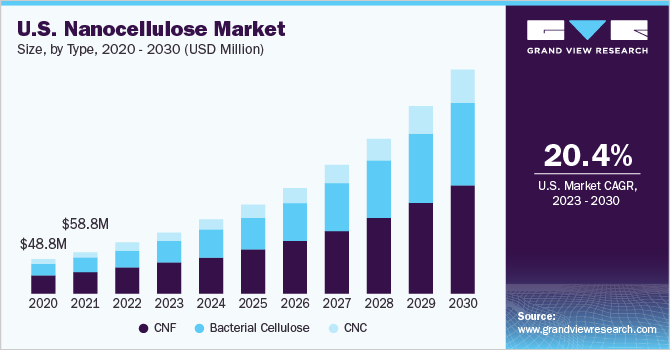The global nanocellulose market size is expected to reach USD 1,517.5 million by 2030 to expand at a CAGR of 20.1% from 2023 to 2030 as per the new report by Grand View Research, Inc. The industry growth is majorly driven by the growing concerns regarding the environment and the use of non-toxic and biodegradable packaging material. This shifting trend is anticipated to augment demand for bio-based products which will propel the demand the forecast period.
Nanocellulose has enormous potential for expansion in a variety of applications, including food packaging, composites, medicines, personal care, and others. However, the use of nanocellulose-based composites and paper processing has widened owing to its environmentally friendly properties.
Due to their physicochemical properties, cellulose nano fibrils are regarded as one of the greatest futuristic materials for the manufacture of textile products. These nano materials offer great stiffness, high strength, low coefficient of thermal expansion, chemical inertness, and the capacity to change their surface chemistry in addition to being renewable and naturally plentiful. Because of these features, manufacturers of textiles and nonwovens are mixing their traditional textiles with these Nano fibrils, propelling the market growth.
Gather more insights about the market drivers, restrains and growth of the Nanocellulose Market
Detailed Segmentation:
Type Insights
Cellulose Nanofibers (CNF) dominated the market with a revenue share of more than 51% in 2022.The highest market share is attributable to the product’s easy availability and improved tensile properties. MFC and NFC (Nano Fibrillated Cellulose) are generally made from wood through mechanical and chemical processing of the cellulose bulk. The availability of wood-based pulp simplifies the manufacturing of these products.
Application Insights
Pulp & paperboard application dominated the market with a revenue share of over 25% in 2022.This is attributed to the growing customer desire for packaging items with little to no processing and no preservatives. The paper industry uses nanocellulose as a prominent sustainable nanomaterial additive owing to its high strength, strong oxygen barrier performance, low density, mechanical qualities, and biocompatibility among the available bio-based resources.
Due to the enormous product mass of paper, paper and board is the most promising sector. In the paper industry, nanocellulose can be used as a dry or wet form for coating paper, manufacturing paper, packing, and making hygienic and absorbent products.
Regional Insights
Europe dominated the market with a revenue share of more than 35% in 2022. This is attributable to the growing demand for pulp and paper combined with prohibitions on single-use plastic packaging, which is anticipated to propel the demand for nanocellulose packaging materials.
Due to its high consumption potential, rising manufacturing capacity, increasing economic development rate, increasing need for lightweight passenger cars, and desire for environmentally friendly food and beverage packaging, North America is expected to be the second largest consumer followed by Europe.
Browse through Grand View Research's Renewable Chemicals Industry Research Reports.
• The global bio-based polyethylene terephthalate market size was valued at USD 2.67 billion in 2023 and is projected to grow at a CAGR of 12.8% from 2024 to 2030.
• The global bio solvents market size was valued at USD 4.06 billion in 2023 and is projected to grow at a CAGR of 3.9% from 2024 to 2030.
Key Companies & Market Share Insights
The market is consolidated owing to the existence of a few major players in the market including Cellu Force, Fiber Lean, Kruger INC., and others. Manufacturers operating in the market engage in strategic mergers & acquisitions, geographical expansion, product developments, and innovation in order to strengthen their positions, increase profitability, and simultaneously generate innovations and advancements.
When compared to other nanotechnology high-performance materials, nanocellulose offers a lower cost and the potential to replace many products made from petrochemicals. It has exceptional qualities like biodegradability, transparency, flexibility, high mechanical strength, and barrier characteristics, among others. Growing interest in health issues and the food & beverage industries will both have a significant impact on the market share in the years to come.
Consequently, the focus on manufacture of the product has increased owing to increasing awareness about health and environmental concerns arising from harmful chemical products. The global market has witnessed several new product developments, mergers & acquisitions and joint ventures due to several industrial challenges.
Some prominent players in the global nanocellulose market include:
• Cellu Force
• Fiber Lean
• NIPPON PAPER INDUSTRIES CO., LTD.
• Kruger INC
• Borregaard AS
• CelluComp
• Melodea Ltd
• Blue Goose Refineries
• GranBio Technologies
• Stora Enso Biomaterials
Nanocellulose Market Segmentation
Grand View Research has segmented the global nanocellulose market report based on type, application, and region:
Nanocellulose Type Outlook (Revenue, USD Million; Volume, Tons; 2018 - 2030)
• CNF (NFC, MFC)
• Bacterial Cellulose
• CNC
Nanocellulose Application Outlook (Revenue, USD Million; Volume, Tons; 2018 - 2030)
• Pulp & Paperboard
• Composites
• Pharmaceuticals & Biomedical
• Electronics
• Food & Beverages
• Others (Textile, Paints, cosmetics, Oil & Gas, Cement)
Nanocellulose Regional Outlook (Revenue, USD Million; Volume, Tons; 2018 - 2030)
• North America
o U.S.
o Canada
o Mexico
• Europe
o U.K.
o Germany
o Netherlands
o France
o Finland
o Norway
o Sweden
o Switzerland
o Spain
• Asia Pacific
o China
o India
o Japan
o South Korea
o Australia
o Thailand
o Malaysia
o Singapore
• Central & South America
o Brazil
o Colombia
o Chile
• Middle East & Africa
o Saudi Arabia
o South Africa
o Israel
o Iran
Order a free sample PDF of the Nanocellulose Market Intelligence Study, published by Grand View Research.



